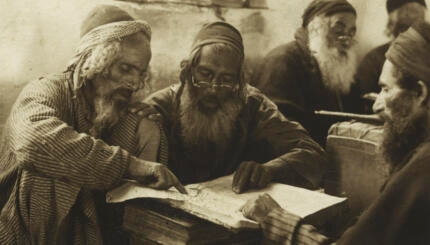In the decades before the Holocaust, the belief in the Messiah was the subject of considerable debate within the Jewish communities of Eastern Europe.
Many young Jews rejected the Orthodoxy of their parents and turned to the great Jewish secular movements of Zionism, socialism, and Bundism [a Jewish labor movement founded in Eastern Europe in the 19th century]. They viewed their parents’ faith in the eventual coming of the Messiah as a dangerous passivity in the face of imminent danger to the Jewish people. They took their fate into their own hands and created new forms of secular Jewish messianic activity. Their concern for changing the world by rejecting their religious background shows how deeply they were immersed in the Jewish search for redemption.
Hasidism, the 18th‑century spiritual movement, also concerned itself with new approaches to redemption. After the [false messianic] Sabbatean debacle of the previous century, Hasidism abandoned active forms of messianism for a system of redemption within the individual. The Baal Shem Tov, the founder of Hasidism, taught that one need not look outside one’s own soul for redemption: “All our prayers for redemption are essentially bound to be prayers for the redemption of the individual.
He urged that we turn inward and seek redemption through seeking transcendence in all our actions and transactions. As Martin Buber, a leading interpreter of Hasidism said, “There is no definite magic action that is effective for redemption; only the hallowing of all actions without distinction possesses redemptive power. Only out of the redemption of the everyday does the Day of Redemption grow.”

Help us keep Jewish knowledge accessible to millions of people around the world.
Your donation to My Jewish Learning fuels endless journeys of Jewish discovery. With your help, My Jewish Learning can continue to provide nonstop opportunities for learning, connection and growth.
Chabad Messianism
Even though it appeared that the idea of a Messiah had run its course, traditional Jewish messianism endures. The Chabad‑Lubavitch Hasidim, one of the largest of the remaining hasidic sects, believes that the messianic age is imminent.
They point to the events of the last several decades‑–the recapture of Jerusalem in 1967; the ingathering of the immigrants from the Soviet Union, Ethiopia, Syria, and Yemen, the Gulf War; and the collapse of Communism in the former Soviet Union and Eastern Europe‑‑-as signs. They believe that if the great majority of Jews repent and return to observance, the Messiah will arrive immediately. Their task, as they see it, is to stand ready for the arrival of the Messiah.
The late Lubavitcher rebbe, Menahem Mendel Schneerson, said that this “generation is the last generation of Exile and the first generation of Redemption (Me-Golah le-Geulah, p.101).” Many of his followers believed that he was the Messiah. They point out that he fit the description of the human redeemer whose good works have brought many Jews back to Judaism. If it turns out that the messianic age is not upon us, they will [likely] attribute that not to him but to the lack of readiness of this generation.
The Lubavitchers seized on his hints and innuendoes about their rabbi’s role as the Messiah, but in the meantime they poured their energy into the observance of the mitzvot.
Zionist Messianism
They have a very different outlook from the extreme religious messianists in Israel, who are preparing to establish the Third Temple on the Temple Mount in anticipation of the Messiah’s imminent arrival. Among the latter are weavers, smiths, and other artisans who have even crafted the vestments, utensils, and paraphernalia necessary to conduct the priestly sacrifices in the rebuilt Temple.
The messianic idea, as opposed to a literal belief in the Messiah, fueled many of the modern Jewish political movements. Zionism, which gained force among the unemancipated Jews of Eastern Europe after 1881, was based on several powerful forces–some modern, some traditional.
Zionism sprouted from the modern political judgment that anti‑Semitism was endemic to European regimes and could not be solved through attempts at societal reform. It also drew upon the romantic nationalistic idea that every people is a nation and every nation should have a state as a national home. Despite the opposition of traditionalists, the modern political aspirations of Jewish nationalists found their deepest psychological support in the Jewish tradition of the messianic return to Zion.
Religious Zionists saw their efforts to rebuild Zion as a partnership with the Messiah. Paradoxically, the popular support for the secular Zionists’ return to Zion came from the centuries‑old tradition of restorationist Jewish messianism, despite the fact that this “return to Zion” would result in a secular parliamentary democracy, not a theocracy.
Secular Messianism
Jewish radicalism can also be seen as a form of modern Jewish messianism. Karl Marx, Rosa Luxemburg, Leon Trotsky and other Bolsheviks, and the New Left of the 1960s are often described as secular Jewish messianists in a “search for redemption that is so strong in Jewish history (Nora Levin, While the Messiah Tarried, foreword).”
According to this theory, you can take a Jew out of the tradition, but you cannot take messianism out of a Jew. [Literary critic] Irving Howe saw messianism as “the most urgent force in Jewish tradition, the force that could send a quiescent people into moments of transport and even collective frenzy (World of Our Fathers, p.223).” He saw socialism and Zionism as secular expressions of this force. The essence of Judaism, in his view, is the hope for a Messiah, which these movements have transformed into a commitment to radical political change.
Liberal Religious Messianism
Modern religious denominations have also had to come to terms with the messianic belief.
Reform Judaism rejected traditional Jewish messianism. Its liturgical changes included the removal from the prayer book of all references to the Messiah and to an eventual return to the Land of Israel. The idea of the personal Messiah was reinterpreted as the longing for universal brotherhood within the context of ethical monotheism. More recently, the Reform concept of messianism has come to mean the result of human effort on behalf of creating the perfect world.
Despite the extremely positive references to the State of Israel in the modern prayer books, there is no preaching of a personal return. This is a messianic age without a Messiah‑‑the fulfillment of the particular destiny of the Jewish people in a modern, universalistic mode.
Conservative Judaism understands the body of rabbinic ideas on messianism as “elaborate metaphors generated by deep‑seated human and communal needs (Emet ve-Emunah, p.29).” The various images of the messianic age express the longing for a time of universal peace and social justice and for the ingathering of all Jews to Israel.
The Conservative movement, however, has replaced the idea of the messianic rebuilding of the Temple by anticipating an age in which the religious and ethical teachings of the will become universal. The Final Judgment is not meant to be taken literally; it is understood as the idea of God’s justice. The Conservative credo is agnostic on the question of the Messiah:
“We do not know when the Messiah will come, nor whether he will be a charismatic human figure or is a symbol of the redemption of humankind from the evils of the world. Through the doctrine of a messianic figure, Judaism teaches us that every individual human being must live as if he or she, individually, has the responsibility to bring about the messianic age (Emet ve-Emunah, p.31).”
Reprinted with the permission of Schocken Books, a division of Random House, Inc., from
What Do Jews Believe?


